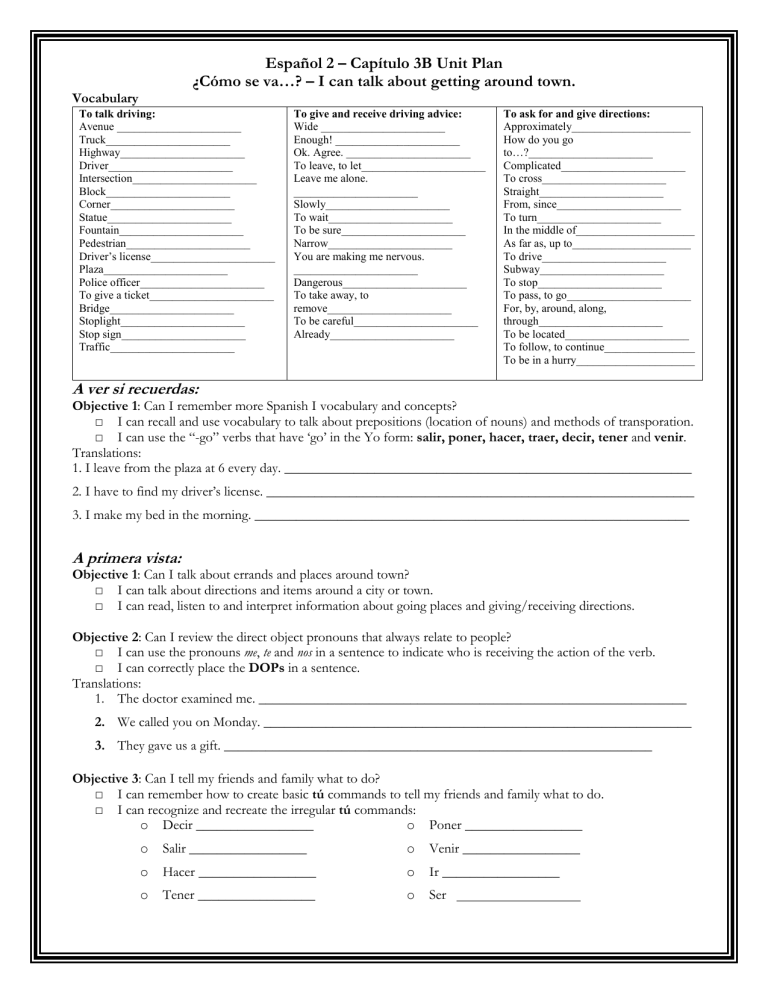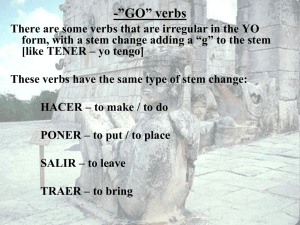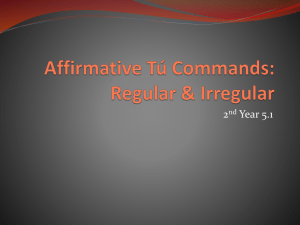
Español 2 – Capítulo 3B Unit Plan ¿Cómo se va…? – I can talk about getting around town. Vocabulary To talk driving: Avenue ______________________ Truck______________________ Highway______________________ Driver______________________ Intersection______________________ Block______________________ Corner______________________ Statue______________________ Fountain______________________ Pedestrian______________________ Driver’s license______________________ Plaza______________________ Police officer______________________ To give a ticket______________________ Bridge______________________ Stoplight______________________ Stop sign______________________ Traffic______________________ To give and receive driving advice: Wide ______________________ Enough! ______________________ Ok. Agree. ______________________ To leave, to let______________________ Leave me alone. ______________________ Slowly______________________ To wait______________________ To be sure______________________ Narrow______________________ You are making me nervous. ______________________ Dangerous______________________ To take away, to remove______________________ To be careful______________________ Already______________________ To ask for and give directions: Approximately_____________________ How do you go to…?______________________ Complicated______________________ To cross______________________ Straight______________________ From, since______________________ To turn______________________ In the middle of_____________________ As far as, up to_____________________ To drive______________________ Subway______________________ To stop______________________ To pass, to go______________________ For, by, around, along, through______________________ To be located______________________ To follow, to continue________________ To be in a hurry_____________________ A ver si recuerdas: Objective 1: Can I remember more Spanish I vocabulary and concepts? □ I can recall and use vocabulary to talk about prepositions (location of nouns) and methods of transporation. □ I can use the “-go” verbs that have ‘go’ in the Yo form: salir, poner, hacer, traer, decir, tener and venir. Translations: 1. I leave from the plaza at 6 every day. ___________________________________________________________ 2. I have to find my driver’s license. ______________________________________________________________ 3. I make my bed in the morning. _______________________________________________________________ A primera vista: Objective 1: Can I talk about errands and places around town? □ I can talk about directions and items around a city or town. □ I can read, listen to and interpret information about going places and giving/receiving directions. Objective 2: Can I review the direct object pronouns that always relate to people? □ I can use the pronouns me, te and nos in a sentence to indicate who is receiving the action of the verb. □ I can correctly place the DOPs in a sentence. Translations: 1. The doctor examined me. ______________________________________________________________ 2. We called you on Monday. ______________________________________________________________ 3. They gave us a gift. ______________________________________________________________ Objective 3: Can I tell my friends and family what to do? □ I can remember how to create basic tú commands to tell my friends and family what to do. □ I can recognize and recreate the irregular tú commands: o Decir _________________ o Poner _________________ o Salir _________________ o Venir _________________ o Hacer _________________ o Ir _________________ o Tener _________________ o Ser Translations: 1. Be careful. _________________________ 4. Turn right. _________________________ 2. Continue straight. ___________________ 5. Go to class. _________________________ 3. Make your bed. ______________________ 6. Come here. _________________________ Objective 4: Can I apply the concepts that I have learned in this unit? □ I can answer the question “Cómo se va... ?” □ I can read about Manejar a la defensive (p. 174) and El barrio (p. 176). □ I can read about driving in the Spanish speaking world. □ I can review and prepare for the chapter test. STUDY GUIDE for Unit Summative Vocabulary – pgs.158-161 and 180 Your notes Direct Object Pronouns, pg. 166 The 5 C’s Irregular affirmative tú commands pg. 168 Test Prep – p. 180-181 Online textbook Communication: to develop the ability to listen, to speak, to read, to comprehend and to write in the target language. Culture: to describe the daily activities of people around the world who are linked to the target language. Connections: to make connections to other core subjects within the use of the target language. Comparisons: to compare and contrast language and cultural practices from one language and/or culture to another. Community: to identify examples of how the target language and cultural practices influence our daily lives.


